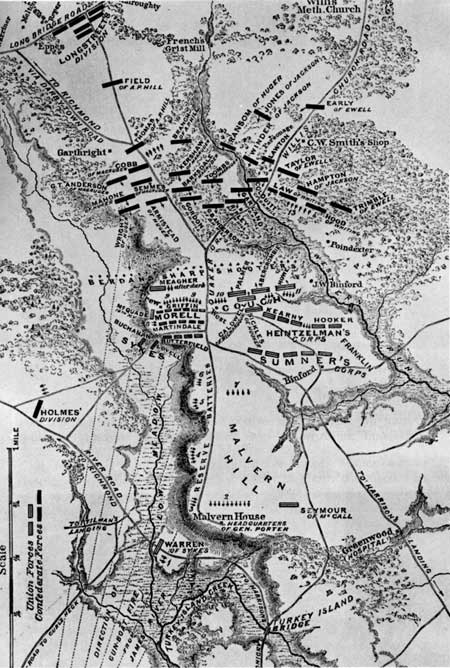|
RICHMOND National Battlefield Park |
 |
PART ONE
THE PENINSULA CAMPAIGN, SUMMER, 1862
(continued)

Battle of Malvern Hill.
From Battles and Leaders of
the Civil War.
Malvern Hill
McClellan had already selected another naturally strong position, this time on Malvern Hill, for the last stand before reaching the James River. On the morning of July 1, Morell and Sykes' divisions of Porter's corps were drawn up on the crest of the hill west of the Quaker road. East of the road Couch's division of Keyes' corps held the front, with Kearney and Hooker of Heintzelman's corps flanked to the right and rear. Sumner's troops were in the rear in reserve. The position was flanked on either side by creeks in deep ravines less than a mile apart, and across this narrow front, Porter placed his batteries with the guns almost hub to hub. In front, the ground was open, sloping down to woods, marshes, and swamps, through which the Confederate forces had to form for attack within range of the Federal artillery.
Lee had Jackson on his left facing Kearney, Hooker, and Couch's right. D. H. Hill was in the center opposite Couch's left and Morell's right. Lee then ordered Magruder to the right of Hill, but Magruder was delayed by taking the wrong road; so instead two brigades of Huger's were placed on Hill's right. Longstreet and A. P. Hill, their ranks decimated from the actions at Gaines' Mill and Glendale, were held in reserve. The terrain rendered it almost impossible for effective use of Confederate artillery, and the few batteries that did get into position were quickly cut to pieces by the massed Union guns.
"Owing to ignorance of the country, the dense forests impeding necessary communications, and the extreme difficulty of the ground," Lee reported, "the whole line was not formed until a late hour in the afternoon." The first real assault did not take place until after 5, and then it was uncoordinated and confused. The signal for the attack was to be a yell from one of Huger's brigades, after the Confederate artillery had blasted a hole in the Union lines. This put the responsibility of where and when to begin the attack on a mere brigade commander.
The artillery was unable to put concentrated fire in any one spot, but Huger attacked regardless and was beaten back with heavy losses. Then D. H. Hill attacked, only to suffer the same fate. Magruder finally sent his troops in a gallant charge across the open fields right up to the cannons' muzzles, only to be mowed down like wheat at harvest time. Late in the battle Jackson sent his own division to Magruder's and Hill's support, but in the heavily wooded and swampy ground they got lost and did not arrive in time to help. Darkness finally put an end to these hopeless attacks. As D. H. Hill declared bitterly, "It was not war—it was murder."

|

|
|
Last Modified: Mon, Mar 4 2002 10:00:00 pm PDT |


